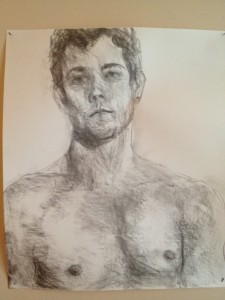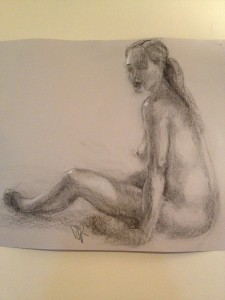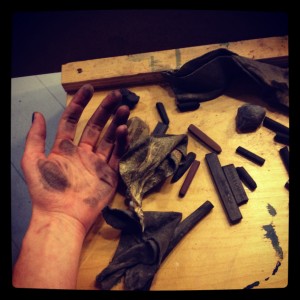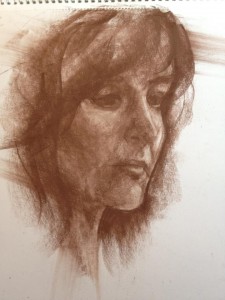Another full-time season is over for my company, and another semester has come to an end for the school. Cue the identity crisis! What on earth am I supposed to do with all this unstructured time? How will I prove my worth to myself if I can’t dance every day?
Ordinarily, these thoughts and worse would be running through my head this time of year. Somehow, it’s different now. I have always envied and admired dancers who could maintain a strong (or at least extant) sense of identity through layoffs. Am I finally becoming one? This installment of Finding Balance is a celebration of summer’s not-guilty-anymore pleasures: rest, leisure, creativity, and study. All are enjoyable, all well-deserved, and all are outpourings of myself. Each creative or restorative undertaking teaches me something I can take into the studio. Each makes my dancing more valuable for those lessons.
One of my greatest creative loves outside the dance studio is drawing. Chance brought me to a facilitated figure drawing session in the spring of 2010, and I’ve attended with relative regularity ever since. My rehearsal and teaching schedule this season finally allowed me to get there weekly (or more, if I was lucky) and seeing consistency pay off has been truly rewarding.
 Honing another craft to a level I can take pride in is a gift to myself. Facing a blank piece of paper, planning a composition (or not), capturing the gesture of a pose, examining the geometry and architecture of the human form…all these things are so similar to dance, just translated from three dimensions to two. Sensitive consideration of the tools (the dancer, music or dance style on one hand, the pencil, charcoal, model, and paper on the other) makes for a better artistic product and a more enjoyable process in any dimension.
Honing another craft to a level I can take pride in is a gift to myself. Facing a blank piece of paper, planning a composition (or not), capturing the gesture of a pose, examining the geometry and architecture of the human form…all these things are so similar to dance, just translated from three dimensions to two. Sensitive consideration of the tools (the dancer, music or dance style on one hand, the pencil, charcoal, model, and paper on the other) makes for a better artistic product and a more enjoyable process in any dimension.
Showing up to those early classes made me nervous! I was mostly learning on the fly, and overwhelmed much of the time. Being in the company of artists I admire and trust kept me coming back. Now, experience and practice have eased those initial fears. I really enjoy how much freedom there is to interpret what’s in front of me once the basics of proportion and tone are more or less in place. As a naturally cautious person, I find a devilish sort of delight in just slapping a bunch of soft charcoal down on the paper and finger-painting with it. Other times I better appreciate the delicate, faintly oily smokiness of graphite, laid down one gentle layer at a time.
 Working loosely without a definite goal in mind is not something I’m usually comfortable with. The progress I’ve made under those conditions offers a few lessons to me:
Working loosely without a definite goal in mind is not something I’m usually comfortable with. The progress I’ve made under those conditions offers a few lessons to me:
- Progress is directly related to consistent practice. Showing up ready to work opens the door to improvement.
- Judging my technique against something concrete (Does is look like the model? Is it at least believable as the likeness of a human being?) is kinder than judging it against a vague set of ideals. (Is this great? Is this skillful? Is this perfect?)
- In a class with no peers, I am free to judge my progress against myself alone. My work will never look like anyone else’s, and shouldn’t. That knowledge makes me both more confident in and more accountable for my own success.
- Analyzing my work, or asking others to analyze it, gives me valuable information about how to use technique. Observing what feelings drawings inspire and why is so much easier with a little perspective.
What I love most about the class is that everyone shows up because we want to create something that day. We arrive needing to express. We get together enough money to pay the model and a little bit of rent, and we make art. It’s such a clear, simple philosophy of creativity. It creates a working atmosphere that’s open, positive, respectful, and vibrant. It reminds me that such a mentality is essential for every art form, and it’s what I try to bring into the ballet studio each morning.
 When I pack up my art bag at 9:15 every Thursday night, I take a lot with me. Pride in my new skills, feedback to contemplate, techniques to try, and a generous mottling of charcoal smudges from face to fingers. I treasure all of it.
When I pack up my art bag at 9:15 every Thursday night, I take a lot with me. Pride in my new skills, feedback to contemplate, techniques to try, and a generous mottling of charcoal smudges from face to fingers. I treasure all of it.
Readers, what other expressive outlets do you use to enrich and inform your dancing? Please share them in the comments section!
Assistant Editor Emily Kate Long began her dance education in South Bend, Indiana, with Kimmary Williams and Jacob Rice, and graduated in 2007 from Pittsburgh Ballet Theatre School’s Schenley Program. She has spent summers studying at Ballet Chicago, Pittsburgh Youth Ballet, Pittsburgh Ballet Theatre School, Miami City Ballet, and Saratoga Summer Dance Intensive/Vail Valley Dance Intensive, where she served as Program Assistant. Ms Long attended Milwaukee Ballet School’s Summer Intensive on scholarship before being invited to join Milwaukee Ballet II in 2007.
Ms Long has been a member of Ballet Quad Cities since 2009. She has danced featured roles in Deanna Carter’s Ash to Glass and Dracula, participated in the company’s 2010 tour to New York City, and most recently performed principal roles in Courtney Lyon’s Sleeping Beauty, The Nutcracker, and Cinderella. She is also on the faculty of Ballet Quad Cities School of Dance, where she teaches ballet, pointe, and repertoire classes.





